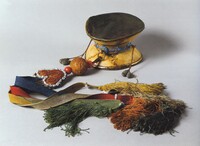Drums in Art

Hand Drum (Skt.: damaru): a double-sided drum made of wood played in the right hand by twisting the wrist and causing the two strikers to beat against the stretched drum skins usually made of hide or snake skin. The damaru is a common ritual object of India. In Tantric Buddhism the drum is often placed next to the two principal ritual objects, the vajra and bell. The dissipating sound of the drum represents emptiness. The drum is generally made of wood although ivory is popular with wealthy teachers and the nobility. Sometimes two human skullcaps are fashioned into a drum exclusively for wrathful Tantric practices. A larger wooden version, round in shape, of the double-sided hand drum is used in the uniquely Tibetan Buddhist practice known as Cutting (Tib. Chod) popularized by the famous female Tantric practitioner Machig Labdron.
An even larger drum is used in temple rituals and dance performances. This drum (Tibetan: nga) is held with the left hand by a long handle and in the right hand a striker is wielded to produce the sound. For permanent installations this drum can be fastened in a wooden frame or suspended by rope from above.
